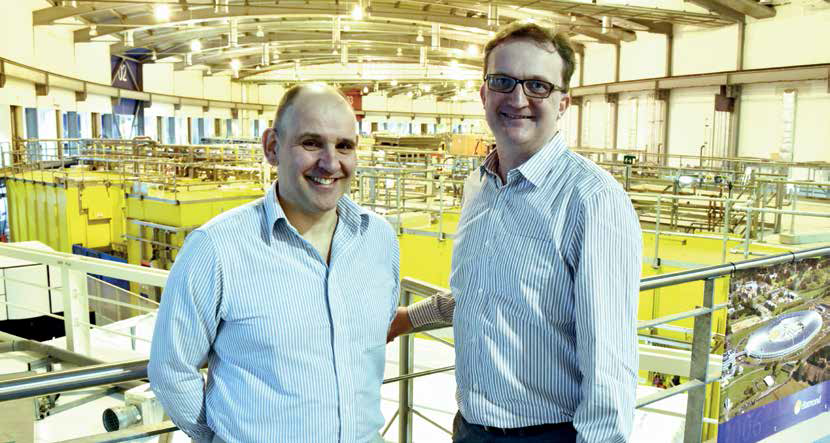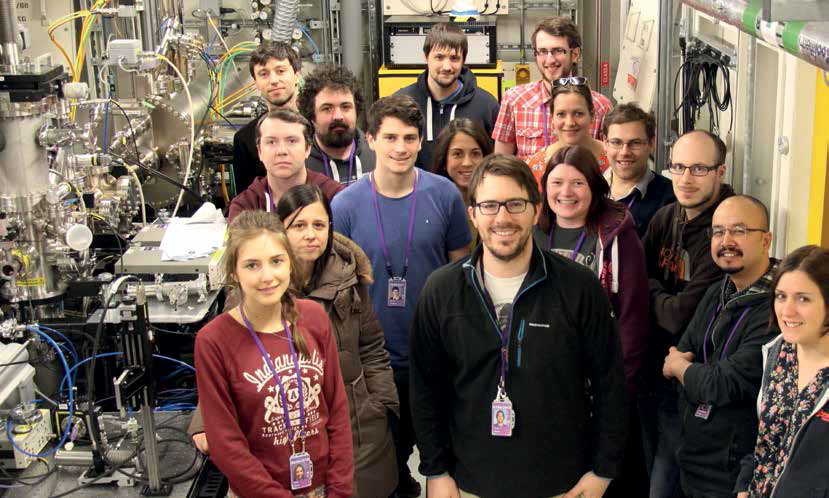Keep up to date with the latest research and developments from Diamond. Sign up for news on our scientific output, facility updates and plans for the future.
Manchester contributed financially to the building of the I13-2 branchline and continues to contribute to its beamline staff, operations and development. Diamond owns and has overall responsibility for the branchline, and provides all other funding necessary to ensure beamline I13 conducts world-leading science. I13 has its own beamline team which is led by Principal Beamline Scientist Professor Christoph Rau.
Manchester has guaranteed access to beamtime at Diamond in return for its investment. The majority of this is taken on I13-2, but substantial amounts of beamtime are available on other beamlines as well. Manchester uses I13-2 for research that spans materials science, biomedicine, geology and engineering, as well as methods development in X-ray imaging and tomography. To complement the work undertaken at Diamond, Manchester has set up a branch of the Manchester X-ray Imaging Facility at the Research Complex at Harwell (RCaH) next to Diamond.
The collaboration recently appointed a new Director, Professor Neil Bourne, who holds a chair investigating matter (materials and structures) under extreme conditions at the University of Manchester. Alongside his role in the collaboration, Prof Bourne is Director of the Centre for Matter Under Extreme Conditions (CMEC) at Manchester, which provides facilities for experimental testing to define properties under mechanical and thermal loads, and modelling of the response of materials and structures. He also advises the UK Health and Safety Executive in regulations and risks in materials and structures. One of Prof Bourne’s aims for the collaboration is to make the I13-2 branchline more widely accessible to academics at Manchester, to develop the capabilities of UK academia and the facility itself, serving as a model for other Diamonduniversity interactions.
Manchester’s role in the collaboration will be to act as a lead in X-ray imaging and tomography for UK academia, working alongside Diamond to develop new techniques. Following on from the initial setup, the collaboration is now ramping up to the operation phase, aiming to bring in new communities, such as industrial users, and for the highest quality published output during the operation of I13-2.
The initial collaboration agreement went up until 2017; the contract has recently been extended to 2020. Both partners view the collaboration as a long-term, ongoing relationship, working together as key national players in X-ray imaging and tomography and providing access to the forefront of new technology.

Professors Neil Bourne and Christoph Rau in the main synchrotron building.
The Hub is a national network with over 35 collaborating universities. It 101 was established in 2013 with funding from EPSRC to coordinate, promote and advance the UK catalysis research portfolio. Its physical centre is located next door to Diamond at the Research Complex at Harwell (RCaH). The project has five themes each directed by a lead investigator from five partner universities:
The UK is strong in these areas of catalytic science but it is recognised that in most cases it is insufficient to investigate chemical processes with a single structural and/or analytical technique. The Hub provides a platform for researchers to work collectively and gain frequent access to the Diamond synchrotron, as well as other facilities at Harwell. A whole system approach to the study of catalysis combined with high throughput allows optimal experiments to be carried out which shorten the path to development of commercially useful products, and promote the UK catalysis effort and expertise on a global stage. The Hub has strong links with Industry which are coordinated by an Industrial Advisory Panel comprising several UK and international industrial members.
One of the main benefits of the Catalysis Hub is sustained access to a synchrotron radiation (SR) source. Members of the Hub may apply for access to Diamond through a BAG mode which has provided the team with up to 18 experimental shifts (6 days) on the Core XAS beamline, B18, per allocation period. This access route increases the efficiency of data acquisition by coordinating projects to reduce the dead time of experimental setup, and by allocating small amounts of time for proof of concept investigations before a full study starts. Applications are judged by a panel of expert academics and beamline scientists, who consider (i) the quality of the underpinning science, (ii) the likely success of the experiments, (iii) bringing in new users of synchrotron radiation, and (iv) coordinating time effectively to maximise efficiency.
This opportunity is open to every academic working in catalysis in the UK. The model of access brings together complementary expertise to ensure that experimental time is maximised, and presents opportunities for researchers that have not used a synchrotron before. The Catalysis Hub team have worked with a variety of catalysis samples, and the B18 beamline team know exactly how to get the best out of the samples they are working on. The method is proving to be a successful one. To date the collaboration has produced over 20 journal papers, which is over 10% of the recorded output from beamline B18.
The UK Catalysis Hub also presents a training experience; a number of PhD students have been placed at the RCaH working on catalysis projects with the Hub. This initiative forms part of the Hub’s aim to develop the next generation of catalytic scientists, through courses, conferences, PhD programmes, summer schools and outreach activities.
Looking to the future the Hub endeavours to achieve its mission to establish a world-leading, comprehensive and coordinated programme of catalytic science in the UK; to develop new knowledge and promote innovation in and translation of catalytic science and technology; and to enable the UK to regain and retain its world leading position in catalysis. The collaboration hopes to achieve this by exploring additional core themes, interacting further with industry, and continuing the successful access model that has been established over the last three years.

The Catalysis Hub team on beamline B18.
Diamond Light Source is the UK's national synchrotron science facility, located at the Harwell Science and Innovation Campus in Oxfordshire.
Copyright © 2022 Diamond Light Source
Diamond Light Source Ltd
Diamond House
Harwell Science & Innovation Campus
Didcot
Oxfordshire
OX11 0DE
Diamond Light Source® and the Diamond logo are registered trademarks of Diamond Light Source Ltd
Registered in England and Wales at Diamond House, Harwell Science and Innovation Campus, Didcot, Oxfordshire, OX11 0DE, United Kingdom. Company number: 4375679. VAT number: 287 461 957. Economic Operators Registration and Identification (EORI) number: GB287461957003.